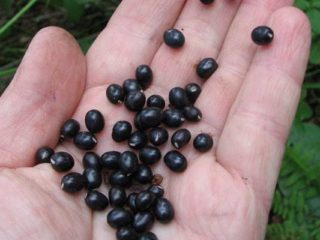Content
Peony Du Tell is an amazingly beautiful milky-flowering variety with a delicate color. Flower lovers have their own secrets that allow them to grow peonies in any area. The variety has worthy characteristics, thanks to which it was awarded the gold medal of the American Peony Society (APS) in 2004.
Description of the herbaceous peony Du Tell
For gardeners, the external parameters of the plant are important. Main characteristics of the flower:
- The bush in adulthood reaches a height of 80 cm. It grows quickly, life expectancy is from 20 to 60 years.
- The rhizome of the “Du Tell” variety is powerful, with thickened edges and fleshy root tubers. The root system grows laterally and in depth.
- The stems are elastic, strong, thin, but able to hold their shape well. Stems with lateral buds.
- Peony leaves are large, dark green, shiny, dissected, slightly corrugated. They give the bush a decorative effect just like flowers. Particularly attractive when the flowering period ends. In autumn they are colored burgundy-red, sometimes with a purple tint.
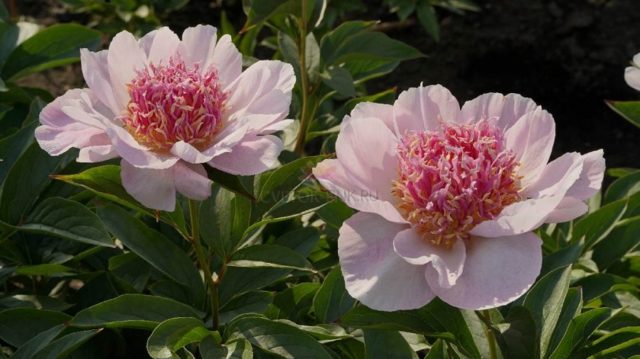
Peony roots grow up to 1 m deep
The peony variety “Du Tell” loves the sun and can tolerate openwork shade or slight shading at midday.Frost resistance is very high. The shoots of the bush do not freeze at a temperature of -30 °C. The variety feels best in the middle zone and grows well in the Moscow region, the Urals and Siberia. Gardeners in the southern regions can also plant the variety on their plots, but with shading.
Features of flowering
Peony Do Tell Do Tell is a Japanese type. This representative of the culture is considered a transitional form from simple peonies to terry peonies. In the “Du Tell” variety, sterile stamens are collected in the very center of the flower and resemble a lush pom-pom. They are dark pink, some are painted red. There are 2 rows of outer petals around (maybe 1 row). The diameter of the flower is about 14 cm. The aroma is delicate and pleasant. A peony variety with a medium flowering period (first half of summer), this period lasts up to 4 weeks. On an adult bush, up to 50 buds open simultaneously.
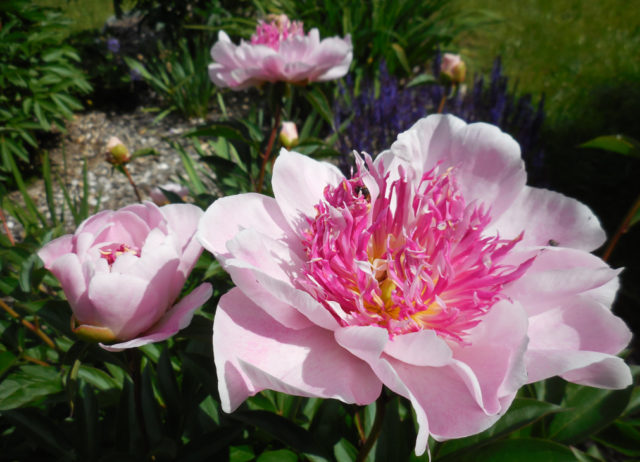
Lush peony flowering is possible only in good lighting
Visually about the variety:
If the bush is planted in the shade, then you should not expect luxurious flowers.
The variety "Du Tell" shows good resistance to rain.
Application in design
Herbaceous peonies are always decorative. The milky-flowered peony “Du Tell” is equally good in any style or design direction. With proper selection of “companions”, it allows you to create various compositions - from the simplest to the most intricate. Just take into account some features of the peony variety:
- Despite its rapid growth, the bush gains the expected decorative value in 2-3 years.
- The variety does not like frequent transplants.
The best partners among perennials for “Du Tell” are phlox, roses, delphinium, sedum, clematis and dicentra.If you play with the difference in foliage configuration, then an excellent combination will be with heuchera, hosta, irises and bergenia. An amazing contrast is created by white and pink peony flowers with burgundy barberry foliage or green conifers.
The Japanese type peony “Du Tell” is planted in groups or single bushes. A group of peonies in the middle of the lawn or on a long discount.
"Du Tell" can be planted in a pot or flowerpot, but only temporarily. In this case, there will be no lush flowering, so for indoor growing it is better to choose the appropriate variety.
Reproduction methods
To independently obtain new plants, it is recommended to use vegetative methods of propagation of the “Du Tell” peony:
- Division of rhizomes. The most favorable time is the end of summer (August) or the beginning of autumn (September). For division, you should choose bushes no more than 4-5 years old. Place the root with adventitious roots in a dark place for 6 hours. Then shorten the length of the adventitious roots to 15 cm. Cut the rhizome into 2-3 parts, each of which should have 2 eyes. Again, put the “divisions” of the “Du Tell” variety in a dark place for 3 days, then treat them with a solution of potassium permanganate and plant them.
- Rooting cuttings. Select a healthy plant in the spring and identify a stem for propagation. Expose the buds, place a frame on top, fill with fertile soil and moisten regularly. In September, separate new “Du Tell” seedlings and replant.
- Pruning. This option can be performed in autumn and spring. As soon as the snow thaws, rake off the soil and cut off part of the rhizome of the variety, which is 6-8 cm below the buds. Then replant.
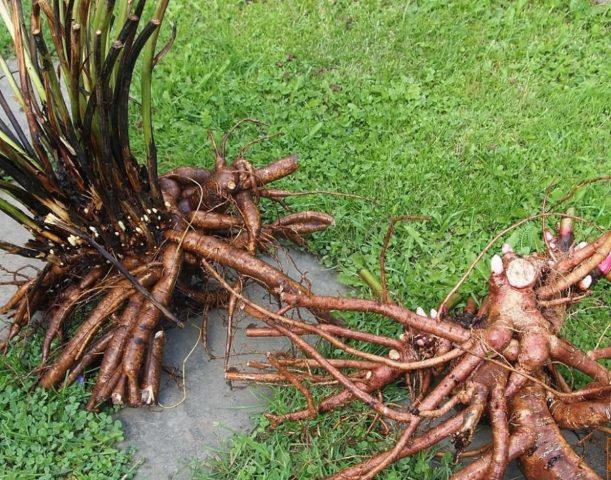
For propagation by dividing the bush, you should choose only healthy and powerful rhizomes
During the first 2 years, the buds on a new bush should be trimmed so that further flowering is lush and long-lasting.
Landing rules
In order for a newly planted bush of the “Du Tell” variety to quickly take root and begin to bloom, the gardener must correctly follow the main steps of the procedure:
- Choose a place. Peony loves sunny areas without darkening. Light partial shade at midday is acceptable. The “Du Tell” variety does not tolerate proximity to tall shrubs, a wide crown of trees, or the walls of houses and buildings. The location of groundwater is no closer than 1.5 m from the surface. Otherwise, prepare an elevation or drainage.
- Stick to the terms. It is recommended to replant peonies in late August or early September. The main thing is that after planting there is at least 1 month left before the onset of the first frost.
- Prepare the soil. “Du Tell” loves fertile soil, but does not make any special demands. Grows best on slightly acidic loams. If the soil is sandy, you need to add clay; if the soil is clayey, add sand. Apply fertilizers, such as compost or humus (200 g per hole).
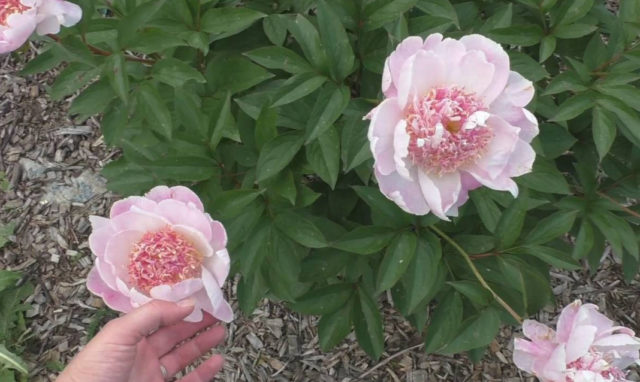
Autumn planting contributes to better adaptation of the peony in a new place
After completing the initial stages, you can proceed to planting the “Du Tell” variety.
The algorithm for spring and autumn events is the same:
- Prepare a cube-shaped hole - 60 cm.
- Lay a drainage layer of fine crushed stone or coarse sand.
- Add a soil mixture of peat, sand and humus to the hole in a ratio of 1:1:1. Mix the composition with potassium sulfate (80 g), superphosphate (150 g), wood ash (300 g). The nutrient layer must be at least 30 cm.
- Place the “division” on the ground with a depth of no more than 3-5 cm.
- Sprinkle with soil from the garden, compact and mulch very carefully.
- Water the new peony seedling. You will need 10 liters of water.
When planting several plants, you need to take into account that each of them needs 1.5 square meters. m. area.
Aftercare
For the “Du Tell” variety, timely watering is important. After planting, it must be repeated after 2-3 days. As the seedling grows, the frequency should be reduced to once a week in a volume of 2-3 buckets of water. Peony does not like stagnant moisture, but the rhizomes should not be allowed to dry out. Take settled water, not cold. The plant needs watering most from late May to early August.

Watering at the root is not recommended, so as not to flood the plant
"Du Tell" needs loosening, which improves the flow of air to the roots. It is better to combine it with watering. The first loosening and weeding should be carried out no later than 2 weeks after planting. Then repeat once a month.
For the first 2 years, the peony is not fed. The food provided during planting is enough for him. For the 3rd year, in the spring, add organic fertilizers (humus, compost). When the budding and flowering phase begins, feed the peony with a mineral complex 2 times (according to the instructions). It is recommended to carry out foliar spraying.
Be sure to mulch. Also remove buds for the first 2 years.
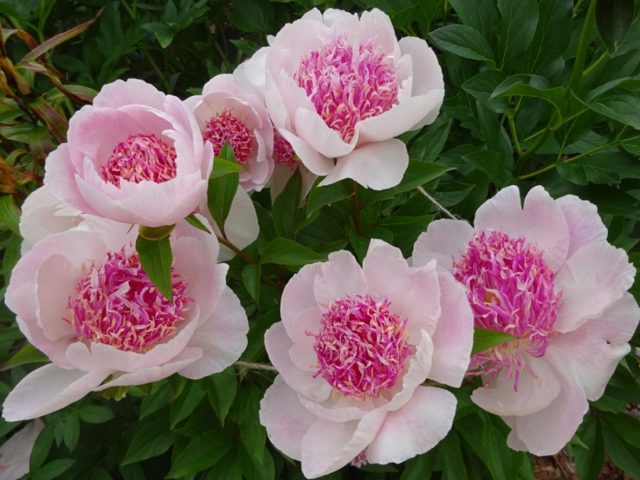
With proper care, the bush blooms long and profusely
Preparing for winter
The first stage of pre-winter preparation is feeding the peony in September with phosphorus-potassium compounds (30 g of the preparation “Autumn” or “Osennee” per 1 sq. m. area). Then cut the bush to a height of 2 cm from the buds and mulch with compost with a layer of 5 cm.Plants need to be covered for the first 2 years in any region, adults - only in the northern regions.
Pests and diseases
For the "Du Tell" peony, fungal infections (Lemoine's disease, rust, powdery mildew) and pests (aphids, thrips, bronze) can pose a danger. It is necessary to regularly inspect the bushes and carry out preventive spraying with folk compositions (infusion of dandelion, yarrow). For lesions, use fungicides or insecticides.
Conclusion
Peony Du Tell is a real decoration of the garden. To get a lush bush, gardeners only need to follow agrotechnical recommendations and take into account the needs of the plant. And then the peony will delight you for a long time with its fragrant white or pale cream flowers.
Reviews of peony Du Tell
Reviews from summer residents help provide a more complete picture of the magnificent Do Tell peony.


